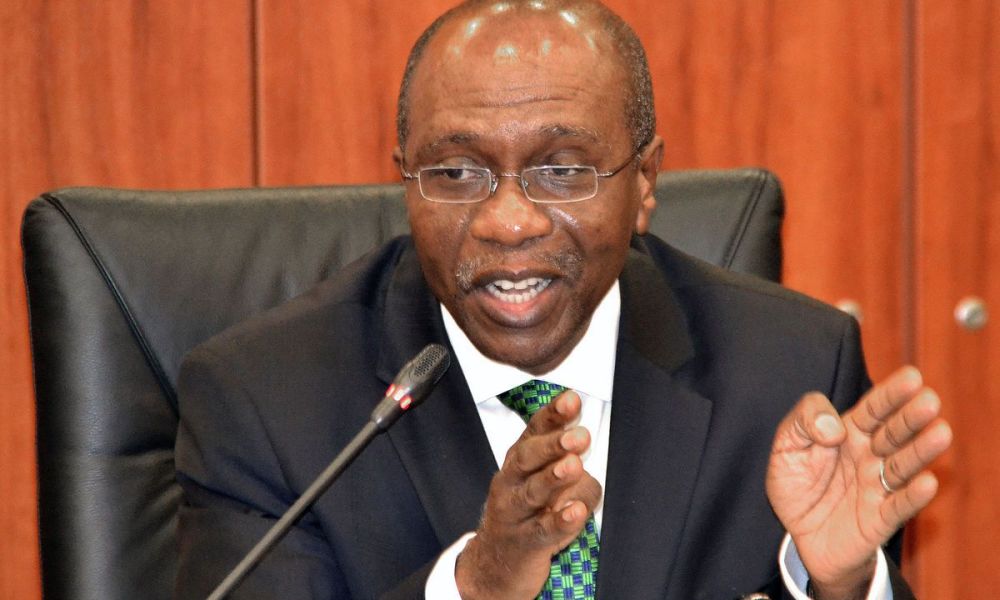By Comercio Partners
The Central Bank of Nigeria (CBN) recently announced the exclusion of non-bank locals (individuals and corporates) from participation in its Open Market Operations (OMO) at both the primary and secondary markets. The exclusion implies that only Deposit Money Banks (DMBs) and Foreign Portfolio Investors (FPIs) can participate in OMOs, while everyone else, including non-bank financial institutions, will have to shift focus to Treasury Bills and other investment options. We believe this policy is in continuation of the apex bank’s attempt at forcing Deposit Money Banks to channel liquidity in the form of credit to the real sector, thereby reducing the continued crowding-out effect on the private sector in terms of real credit growth to the economy. Recall that the bank recently recalibrated its Loan to Deposit Ratio (LDR) limit for banks from 60% in September to 65% with a 31st December 2019 deadline.
According to CBN data, the use of OMO bills as a liquidity management tool dates back to 2007 when the bank issued a N27 billion 174-day paper. This process was predominantly an arrangement between the Central bank and deposit money banks. It is however important to note that the proliferation of OMO bills over the years (rising from just under N30 billion in 2007 to over N13 trillion thus far in 2019, with a peak of over N17 trillion last year) has necessitated the participation of other market players including local corporates, fund managers, pension fund managers as well as foreign portfolio investor.
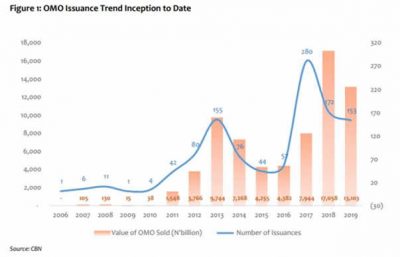
The rise in the issuance of OMO has essentially been on the back of the apex bank’s preference for the tool with regards to foreign exchange management as its auctions have continued to attract an increasing number of foreign portfolio managers who are happy to take on Naira risk at those yield levels.
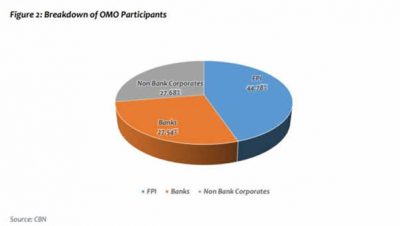
Over the last couple of years, OMO issuance has outstripped regular NTB issuance, significantly increasing the cost of liquidity management as the apex bank keeps the rate attractive to ensure a continuous flow of “precious” foreign exchange to keep the Naira stable.

More Joy For Offshore Investors
The apex bank recently released another circular stating that it would provide a one-way quote in the market particularly for OMO bills. This was in a bid to address the liquidity concerns raised by foreign portfolio managers. We also highlight how this policy has impacted various markets and the likely hood of the sustainability of this impact.
How Low Can These Yields Go?
Since the release of the circular by CBN, yields at the primary market auction has declined quite significantly as the market remains thin on volumes. Bond yields have declined significantly across the curve with the 5-year declining by 158bps to 12.05%, 10-year bond yields have shrunk by 103bps to 13.14% and the yield on the 30-year bonds is down by 81 bps to 13.68%. We expect yields to decline further on the back of the resolution of the CBN to stay true to their new policy and the anticipated OMO maturities repayment. The question here is how far can these yields fall off to make a plunge into risk assets worth the while of market participants.
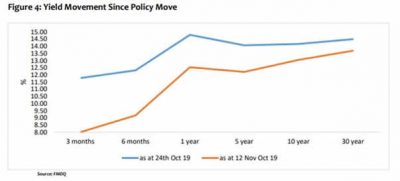
We have also seen a significant drop in Fixed deposit rates with tier 3 banks offering single-digit fixed deposit rate as opposed to the over 14% they were offering prior to the policy pronouncement. This is clearly reflective of the general paucity of investment outlets as participants scramble to deploy investible funds in limited outlets.
Banks’ Profitability Could Take A Hit
CBN claims this new policy directive is to drive more lending to the real sector, we see this play out in different ways in banks’ balance sheets. During Q3 results presentation some banks revised their deposit growth forecast downwards by as much as 10%-20% and revised upward the loan growth assumption, this speaks directly to the loan to deposit threshold of 65%. However, this is unlikely to happen as the new CBN circular has created a wall of money (due to the paucity of investment outlets) which will sit with the banks making it difficult to meet the LDR requirement– this would easily see further debits in December, crimping the banks’ profitability. The possible upside to this new policy for banks is, will see a possible decline in interest expenses, therefore, increasing interest income.
The Equities Market
The equities market has been on a downward trend since 2018, recording a negative return of 18% in 2018 and currently down by 15% year to date. In terms of relative valuation, the Nigeria local bourse is currently trading at 6.7x LTM earnings compared to its peer average of 11.5x LTM earnings. Nigeria’s risk assets have become significantly cheaper this year as slow economic growth, little or no traction on the reform front as well as a significantly reduced consumer discretionary income continue to weigh on investor sentiment. It is only a matter of time before investors begin to consider if the risk in equities would outweigh the fast dwindling, relatively safe returns in fixed income. Investors would also be considering the compelling dividend yields on some bell-weather names.
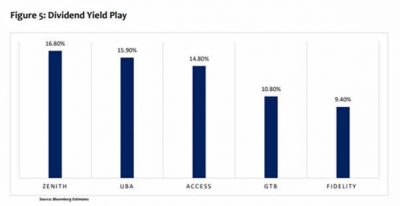
The chart above clearly shows dividend yields in excess of current fixed income yields, this presents a compelling case for a dividend yield play.
Equities Could Get A Look In….
As for fixed income, we would recommend that investors go long on the curve as yields are set to decline further-the liquidity surfeit coupled with limited outlets would continue to exert downward pressure on yields. It remains to be seen how low these yields would go before investors start to blink. We think that once the 1-year T-bill rate begins to drop below 9% which would imply a negative real return of over 2 (Considering inflation at around 11%), investors are likely to begin to reassess their options as to the best way to optimize returns.
On the equity front, we are of the opinion that there would be a gradual return of local fund managers into the market as they weigh the risk of initiating exposure to equities. While most local fund managers still feel reluctant to return to equities, we believe that this policy move has set the stage for an inevitable return. It, however, remains to be seen the sort of exposure that they would be looking to have. We believe that bell-weather stocks with dividend yields north of 10% present a compelling case for investing as the holding period would be for about four months at the most (most bell-weathers have a December year-end). Again, this outlet is fraught with a lot of risk as the headwinds to equities are in place and remain formidable.


